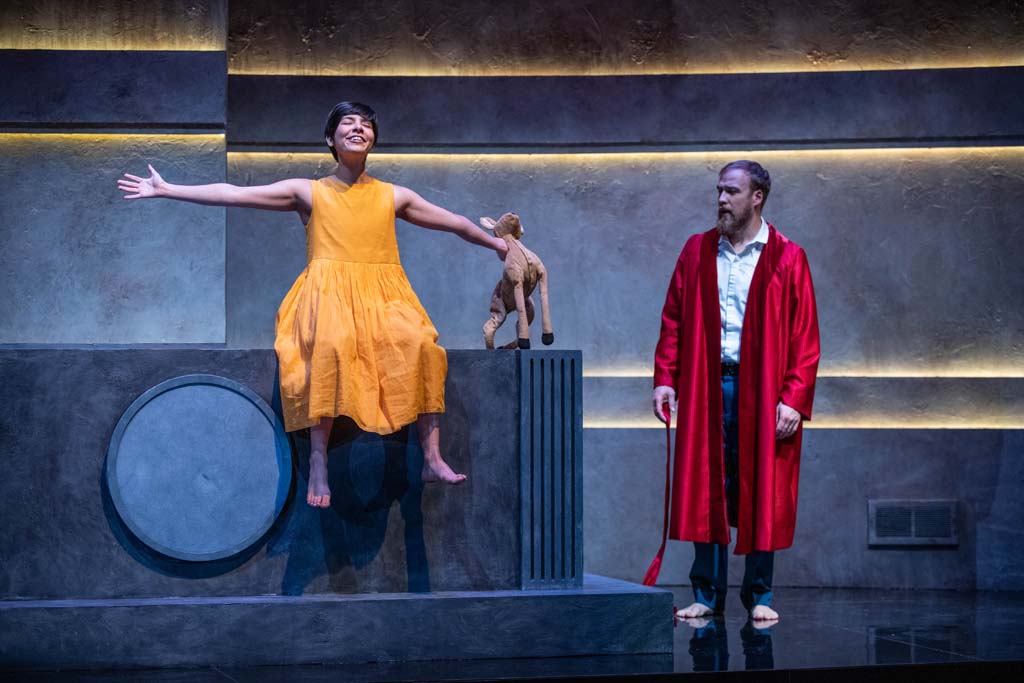Oresteia
Adapted by Robert Icke
Directed by April Cleveland
May 3–12, 2019
The Theatre School at DePaul University
Watts Theatre
Chicago, Illinois
Reviewed by Laura Gawlinski
Loyola University Chicago
“If the questions at the heart of this play confound you and take your breath away, the Greeks have done their job.”
April Cleveland (director’s note, Oresteia program)
Robert Icke’s adaptation of Aeschylus’ Oresteia twists the themes and conflicts of the three ancient Greek plays that make up its source material into fresh horror for the modern stage.1 Icke taps into the big-picture issues that are worked out through the mythology of Orestes and his family—the steep costs of war, the nature of justice, the marginalization of women, the role of religion in politics, and the irreconcilability of obligations to family and state—to create a work that feels both novel and timeless. First staged at London’s Almeida Theatre in 2015 as part of a season of Greek-based productions and events, the play had a successful U.S. premiere by the Theatre School at DePaul University under the direction of April Cleveland (MFA Directing 2019) in May 2019.
The premise of the adaptation does not stray much from the essential elements of the ancient Greek story: a leader is compelled to kill his own daughter to ensure military victory; after he returns home with a war refugee, he is murdered by his wife, their son is driven to avenge him, and the morality of the son’s matricide is turned over to the legal system to decide. But this Oresteia, condensed to four acts and a runtime of about two-and-a-half hours with one intermission, is told from the point of view of Orestes’ memories of the events, befuddling the plot as it progresses as though filtered through a dream. Orestes attempts to answer his examiners in court and interacts with flashbacks as they unfold on the same stage, but it is impossible for the viewer to tell what “really” happened. That Orestes was merely a child when his family’s issues began, with a child’s skewed perception, is emphasized when the young-adult Orestes (Garrett Young) watches his younger self (Adam Todd Crawford) in some of the early flashbacks. What the audience sees on stage through Orestes is not only a dubiously accurate recollection of events; it is strongly implied that an accurate recollection is not even possible. Accuracy is further brought into question by frequent allusions to political machinations and media spin. For example, Agamemnon makes a plan with his brother and advisors for how best to hide the circumstances of his daughter’s death, and Clytemnestra tries to control the public presentation of herself and her family. The debate in this play is not simply between Clytemnestra’s side and Agamemnon’s side, matricide and mariticide, but poses the question of whether it is even possible to know the “truth” and, consequently, whether real justice is inevitably elusive.
|
Figure 1: Photo by Michael Brosilow. Featuring Tiff Abreu (Electra), Gabby Gillespie (Cilissa), Jasper Johnson (Talthybius), Jayson Lee (Calchas), Amanda Pulcini (Klytemnestra), and Matthew Wade (Agamemnon). |
The dreamlike effect of the play is further achieved through a disorienting setting that cannot be pinned down to a precise time or place. The costumes, diction, and technology are all contemporized. Characters are often interviewed as though for television, with the resulting video simultaneously projected on the back wall of the stage (Fig. 1). Agamemnon’s attempt to explain to a news anchor why the upcoming war is necessary feels very modern, while the projection of the video behind makes him larger than life to fit his role. The choice of “Fools Rush In (Where Angels Fear to Tread)” as Iphigenia’s song is suitably nostalgic without taking the mood out of the present day.2 But there are also fantastical, otherworldly elements, as Icke does not rationalize away all the supernatural oddities of Aeschylus in his modernization: Agamemnon (Matt Wade) still believes in omens and consults the soothsayer Calchas (Jayson Lee), and both the goddess Athene (Carolyn Hu Bradbury) and a blood-covered Fury/Kindly One (Gabby Gillespie) are a part of the court proceedings. The viewer is additionally unsettled by the vagueness of “the enemy” and the threat it poses; it’s unclear where the war takes place or what kind of military force is involved. These features transform the story into something happening in a galaxy far, far away, an alternate universe that looks like us but is not exactly us—not so different from our relationship to the ancient Greeks themselves.
Icke conceptualizes the actors in his adaptation as working together like a chorus “who move fluidly between roles with a minimum of costume changes.”3Lines spoken in unison or intended to overlap retain a bit of the original choral feel, and several actors perform more than one role. When Matt Wade emerges again after the murder of Agamemnon to play Aegisthus, it causes at least momentary confusion about whether we are viewing Agamemnon in a flashback, or even in the form of a ghost. There are other kinds of doubling as well. The visual connection between Iphigenia (Fig. 3) and Cassandra (Fig. 2; Carolyn Hu Bradbury, who also plays Athene) adds new layers to those characters, both girls who are at the mercy of the adult, male world around them. Orestes at his two different ages is played by two adult actors with the skills to make their divergent ages believable—just one example of this production’s spot-on casting. Similarly excellent performances with sensitivity to the age of the characters come from Vero Maynez as little Iphigenia and Amanda Pulcini, who brings the gravitas of Klytemnestra.4
|
Figure 2: Photo by Michael Brosilow. Featuring Tiff Abreu (Electra), Carolyn Hu-Bradbury (Cassandra), Amanda Pulcini (Klytemnestra), Katie Travers (Doctor), and Matthew Wade (Agamemnon), and Garrett Young (Orestes). |
Good use is made of the space of the Watts Theatre for staging this work. It is clear from the actors bustling about with clipboards and papers as the audience settles in before the play begins (and from familiarity with the setting of Aeschylus’ Eumenides) that the location is a courtroom, but that courtroom, malleable in its neutral gray tones, fluidly serves as all the settings. There are no major scene changes, and actors and crew make minor adjustments to the set during pauses announced to the audience. This creates more muddling: the setting is never not a courtroom, even during the most intimate domestic scenes (Fig. 2). The interior life of the family is visually blurred with the facade it presents to the community; the conflict between oikos (home) and polis (city-state) is at the heart of the trilogy.
Music is used sparingly, so that Iphigenia’s song (sometimes sung by her, at other times played from the professional recording) stands out all the more. Otherwise, the main sound effect is an occasional loud ticking, emphasizing the countdown of a digital clock hanging above the stage. This clock highlights what the audience already knows, that time is running out for the characters on stage, and that these events that are happening have already happened, both within the play itself (they are already Orestes’ memories) and within the established mythological canon (everyone, for several millennia, has known the outcome).5 The times of death announced for the various characters change for each performance, since they are tied to the actual running of the clock. The audience is also blended into the world of the play, as the same clock is used to mark the approach of the formal beginning of the performance and the single intermission (during which the overall countdown is paused).
Violence is central to Greek tragedy, and this adaptation incorporates that violence in a more direct—and arguably more effective—way than stagings that follow ancient conventions more closely. The size of the Watts Theatre (a thrust theater holding no more than 250) is especially suited for such intense physicality, its smallness creating an intimacy between characters and audience that makes the horror more palpable. The expertly directed murder of Agamemnon unfolds like a gruesome messenger speech come to life and involves multiple, concurrent actions on different areas of the stage while the now-familiar strains of “Fools Rush In” blast at warped tempos. Watching Klytemnestra drag the lifeless body of her freshly-slaughtered husband down the stairs away from the tub, awash in blood, the audience experiences the slow, deliberate pulling and thudding as a buildup of lurid tension, accentuated by the unconscious realization that this is live theater with live actors exhibiting real physical exertion. When the dragging ended before the final set of stairs (the ideal stopping point), I realized I had been holding my breath. Klytemnestra is unhinged in her revenge, culminating in a chilling yet sympathetic soliloquy, masterfully delivered by Amanda Pulcini, in which she proclaims that she enjoyed what she did, loved the blood, and would do it again if she could:
… and I open my mouth
like a plant in the rain in the red and I feel so
awake, it’s like liquid rightness pumping into
arteries, he’s dead, I am alive – and I’m free –
and from this point, from now, this house is
set in order ONCE AND FOR ALL.6
In addition to the outright violence here, other scenes toy with a line between intimacy and violence, as when an attempt at a physical reunion between Clytemnestra and Agamemnon turns ugly. Rachel Flesher (Violence/Intimacy Director) and Zack Payne (Assistant Violence/Intimacy Director) are to be commended for their roles in the execution of the many delicate and precarious scenes.7
The play is billed as an adaptation of Aeschylus’ Oresteia trilogy (featuring elements of Agamemnon, Libation Bearers, and Eumenides), but some parts of the mythos are expanded or moved, most obviously in the opening act, which introduces Calchas and his prophecy, Iphigenia, and Agamemnon’s struggle with his role in sealing his daughter’s fate. This choice is especially striking when considered alongside the recent local performances of the “Greek Cycle” at the University of Chicago Court Theatre, which trod essentially the same tragic ground, but through three different playwrights: their Agamemnon (2015) was preceded by Euripides’ Iphigenia at Aulis (2014). Presenting Iphigenia in the flesh to audiences significantly shifts the tone and focus set by Aeschylus. Is this a modification our current age requires? We are now unwilling to view Agamemnon without explicating this particular flaw, and unable to imagine a Klytemnestra without fully experiencing her maternal motivations.
|
Figure 3: Photo by Michael Brosilow. Featuring Vero Maynez (Iphigenia), and Matthew Wade (Agamemnon). |
Transferring Iphigenia and her death from a description in a choral song (Agamemnon lines 184–247) to embodiment on stage enriches this adaptation as a whole. I was put on edge from the moment a stuffed animal—a deer!—appears mysteriously at the home. This foreshadowing returns in a dinner scene in which Iphigenia, upset that the meal includes venison, is instructed that animals must be sacrificed in order for people to eat. This correlation between animal and girl, who also must be sacrificed for the greater good, works both in the world of the play and in the broader world of myth. The color and cut of Iphigenia’s dress (Fig. 3), yellow and loose, is a facsimile of the costume (the krokoton) of the little girls who played the bear at Brauron, further tying her to Artemis and alluding to her mythic fate.8 When Iphigenia eventually returns on stage as a mere shadow running uncannily though the background, the scene is all the more disturbing because the audience has already met her pre-ghost form.
Other aspects of the sources materialize in innovative ways. When Cassandra appears and eventually breaks her silence, it is as jarring as it is in Agamemnon, but the surprise this time is that she screams out in ancient Greek. This language, which the other characters say they cannot understand, marks her as a foreigner and a speaker-in-tongues, while also bringing in the original speech of Aeschylus himself. (I was unable to catch which lines were chosen for this production, and Icke’s text only indicates that lines from the original plays should be used.) Fragments such as “God. The word was there in the beginning” (John 1:1), tucked into the opening speech of Calchas, are like Easter eggs for any audience members trained in the canonical texts of ancient Greek. Because Icke’s adaptation is not a translation—the original is quite different—the explicit inclusion of ancient texts creates a stronger link to the original plays as well as to the wider Greek environment into which they fit. But detailed familiarity with that world is not necessary for the audience. Discussion during the talkback I attended revealed how much the use of bare feet (Figs. 2 and 3) and nets struck a chord with the audience, without anyone really needing to know that these are actually from Aeschylus, just by way of Icke.9
The continuing relevance of the themes of most ancient Greek tragedies in some ways makes them easy to adapt: they already resonate with modern audiences. A recent review even notes that there were three wholly different performances of adaptations of the Orestes cycle in the summer of 2019 alone. The truly great adaptations can both stand on their own and make us think about the originals in new ways. Robert Icke’s Oresteia modernizes the old story and raises its stakes. The horrific dreamscape of impossible decisions generated by this DePaul production confirms that this is definitely a play to see live, and I look forward to productions becoming more common following this evocative debut.
Notes
1 Robert Icke, Aeschylus Oresteia: A New Adaptation (London: Oberon Books, 2015).
2 The London production used the Beach Boys' “God Only Knows” (Icke, Aeschylus Oresteia, 8), from the same era.
3 Icke, Aeschylus Oresteia, 9.
4 Icke’s production was able to use child actors for the roles of young Orestes and Iphigenia.
5 This clock is a hallmark of Icke’s that he also used in his Romeo and Juliet adaptation for similar purposes, counting down to the inevitable conclusion and indicating the times of deaths.
6 Icke, Aeschylus Oresteia, 81.
7 The importance of the work of these directors is worth emphasizing, especially in light of the abuses in the Chicago theatre scene that led to the creation of Not in Our House and the Chicago Theatre Standards. See Aimee Levitt, “Nearly a Year after Profiles, Chicago Theater Professionals Are Still Learning to Talk to Each Other About Abuse,” Chicago Reader, March 28, 2017.
8 The dress is alluded to by Aeschylus (Agamemnon line 239, κρόκου βαφάς) and stipulated in Icke’s stage directions, “In the house, IPHIGENIA enters, wearing a saffron dress, carrying a doll” (17). For the dress, see the girls on a black-figure krateriskos from the Athenian Agora (P 27342).
9 For the meaning of footwear and its absence in the plays, see Daniel B. Levine, “Acts, Metaphors, and Powers of Feet in Aeschylus’ Oresteia,” TAPA 145 (2015): 253–80 and Susanna Phillippo, “Stepping on the Stage: Aeschylus’ Oresteia and Tragic Footwear,” in Shoes, Slippers and Sandals: Feet and Footwear in Classical Antiquity, ed. Sadie Pickup and Sally Waite (London/New York: Routledge, 2019), 143–73.



